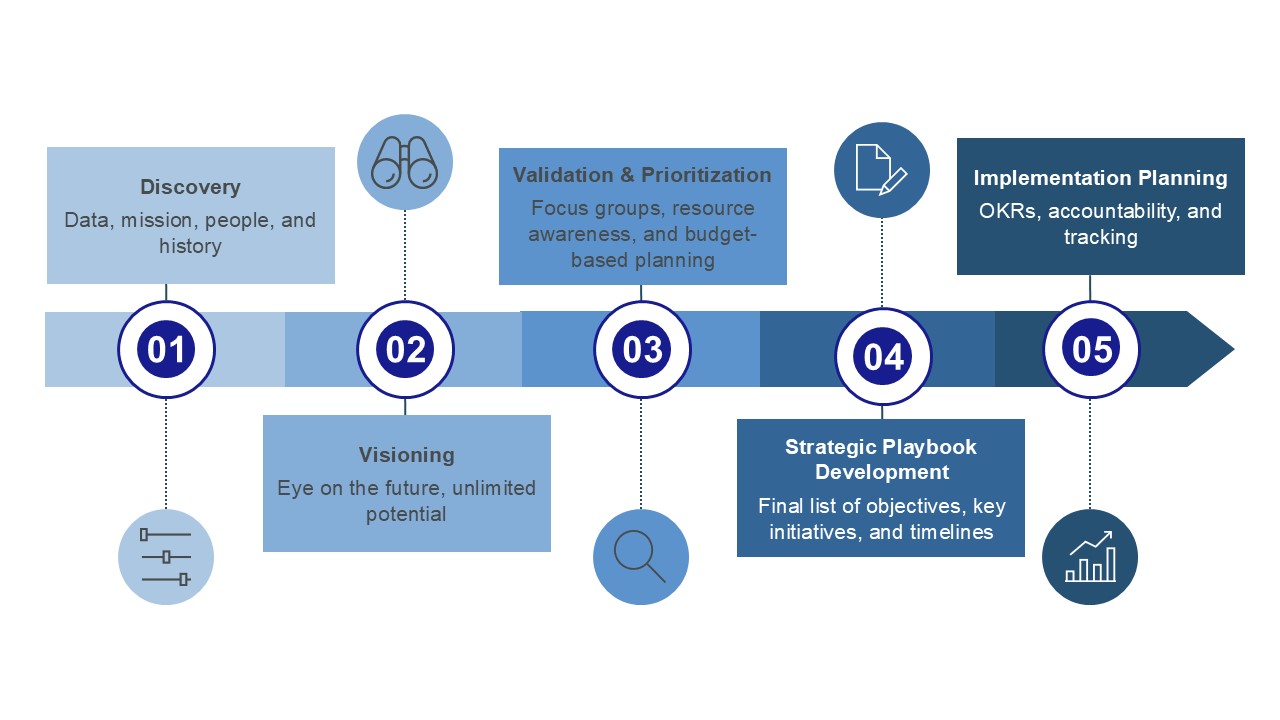If you’re like many higher education institutions, you have a beautiful PDF or digital flipbook on your website that outlines a five to 10-year “strategy.” This document codifies your commitment to build enrollment, sustain your financial position, and increase your research productivity or alumni engagement. It was built through an unapologetically inclusive process. The plan is a comprehensive set of goals for your institution written by a collection of stakeholders. Sometimes, these plans are used for fundraising and are often allocated significant resources for implementation.
But are these strategic plans actually strategic? Or are they simply extensive, but generic, reiterations of mission and values?
Plans are strategic when they:
- Are driven by a long-range vision for the future
- Offer a road map for achieving a competitive advantage or market distinction
- Anticipate trends in an uncertain environment
From the Past to the Future
One of the problems plaguing higher education today is that it hasn’t done a good job of any of the above. Most vision statements are the product of the plan rather than a north star on which the organizational plan is built. Many institutions pay less attention to their peers than they should, or they focus too much attention on trying to build their way into an elite group of institutions that is ultimately impenetrable. And too many constituents dedicate their time to doubling down on what they’ve done well rather than what their resources will allow them to address moving forward. As an industry, we have not anticipated the future so much as we have worshipped our past.
A good strategic plan should energize your constituents—internal and external—and serve as a blueprint for a future that will transcend them. So, how do we rally our faculty, staff, students, and alumni around a vision?
One giant step forward would be to develop systematic strategic thinking on our campuses. We can accomplish this with transparency and strong leadership, anchored by a study of the past, an understanding of the present, and an appreciation for what’s next. That “what’s next” piece is especially challenging on many campuses. It requires us to accept that the headwinds we face are outside of our control. Except in the case of an elite few, these headwinds are unrelated to our past or present excellence.
Why Forvis Mazars
At Forvis Mazars, we’ve been facilitating strategic plans for more than 15 years. We’ve made our mark in higher education primarily through our work with academic medical centers. Our clients in this space are often repeat clients because they recognize the energy and action that follow a well-designed strategic plan. Our Visioning session, in particular, sets us apart from other vendors selling strategic planning. It is designed to excite people for the future, thinking in ways they’ve likely never thought before.
We believe that the people leading higher education today are ready to engage in the kind of transformative strategies that have benefitted other industries over the last century. We need to look only at the rise of the chief strategy and chief investment officer roles as evidence of this.
The Forvis Mazars Difference
Our approach addresses the most likely causes of strategic plan failure or apathy by starting big and working backward from success. After learning about your mission, culture, history, and historical and current data, we launch into a Visioning session that considers a variety of stakeholders and develops strategic thinking skills that let go of constraints on our creativity. Then, we help you identify potential barriers and associated mitigation strategies as well as narrow your priorities to align them with resources, landing on a long-range strategy that differentiates and adapts. We help you move to a future where your mission is front, center, and realized. During the process, we bring our proprietary tools for benchmarking and financial planning into the fold to promote a comprehensive approach. Image contains a graphic with 5 stages. Stage one is discovery and validation with the subcontent of data, mission, people, and history. Stage two is visioning with the subcontent of blue sky and eye on the future. Stage three is strategic playbook development with the subcontent of resource awareness and prioritization. Stage four is implementation planning with the subcontent of timelines and budgeting. Stage five is monitoring and evaluation with the subcontent of KPIs, reporting, and adaptation.
Image contains a graphic with 5 stages. Stage one is discovery and validation with the subcontent of data, mission, people, and history. Stage two is visioning with the subcontent of blue sky and eye on the future. Stage three is strategic playbook development with the subcontent of resource awareness and prioritization. Stage four is implementation planning with the subcontent of timelines and budgeting. Stage five is monitoring and evaluation with the subcontent of KPIs, reporting, and adaptation.
Our higher education strategy team consists of former faculty members, trustees, internal auditors, and finance professionals. We understand the value your institution brings to the collective future. We also understand that you serve constituents who have a role to play in visioning and prioritization. Therefore, our approach is built on the assumption that inclusivity and strategy are not mutually exclusive.
If you’re ready to launch and execute a strategic planning process that guides you to your forward vision, visit our Higher Education Consulting page for more, or reach out to a professional at Forvis Mazars today.
Strategic Planning Booklet
Helping you prepare for what’s next.
